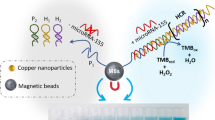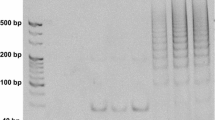Abstract
A novel chemiluminescence (CL) aptasensor for highly sensitive detection of small-molecule targets using cocaine as a model analyte was developed in the present study. For the proposed aptasensor, the aptamers were immobilized on the surface of gold nanoparticles (AuNPs) functionalized magnetic microbeads (MB-AuNPs) and then hybridized with the signal DNA on the double-functional gold nanoprobes (DF-AuNPs) modified with horseradish peroxidase (HRP). When cocaine was introduced, a competition for the aptamer between cocaine and the signal DNA occurred and the gold nanoprobes were forced to dissociate from the MB-AuNPs surface based on the structure switching of the aptamer. The CL signals of Luminol-H2O2-HRP-PIP system were proportional to the concentration of cocaine. A linear range was obtained when the concentrations of cocaine were from 1 × 10−9 to 1 × 10−8 M with the detection limit of 0.48 nM (3σ), much lower than those achieved by other methods. This new system can be easily extended to a variety of small-molecules, protein, and tumor cell analysis.







Similar content being viewed by others
References
Reimers JR, Wang Y, Cankurtaran BO, Ford MJ (2010) Bonding and orientation in self-assembled monolayers of oligophenyldithiols on Au substrates. J Am Chem Soc 132:8378–8384
Katz E, Willner I (2004) A nanocatalyst-based assay for proteins: DNA-free ultrasensitive electrochemical detection using catalytic reduction of p-nitrophenol by gold-nanoparticle labels. Angew Chem Int Ed 43:6042–6108
Li J, Song S, Liu X, Wang L, Pan D, Huang Q, Zhao Y, Fan C (2008) Enzyme-based multi-component optical nanoprobes for sequence-specific detection of DNA hybridization. Adv Mater 20:497–500
Park SJ, Taton TA, Mirkin CA (2002) Array-based electrical detection of DNA with nanoparticle probes. Science 295:1503–1506
Cao YC, Jin R, Nam JM, Thaxton CS, Mirkin CA (2003) Protein nanostructures formed via direct-write dip-pen nanolithography. J Am Chem Soc 125:14676–14677
Nam JM, Park SJ, Mirkin CA (2002) Nanoparticle-based bio-bar codes for the ultrasensitive detection of proteins. J Am Chem Soc 124:3820–3821
Nam JM, Stoeva SI, Mirkin CA (2004) Bio-bar-code-based DNA detection with PCR-like sensitivity. J Am Chem Soc 126:5932–5933
Rosi NL, Mirkin CA (2005) Nanostructures in biodiagnostics. Chem Rev 105:1547–1562
Bi S, Zhou H, Zhang S (2009) Ultrasensitive flow injection chemiluminescence detection of DNA hybridization based on bio-bar-code functionalized magnetic nanoparticle label. Chem Commun 37:5567–5569
Zhong H, Lei X, Hun X, Zhang S (2009) Design of one-to-one recognition DNA probe based on triple Au nanoparticles bio bar codes and its application in the electrochemical DNA biosensor. Chem Commun 45:6958–6960
Yang X, Guo Y, Bi S, Zhang S (2009) Ultrasensitive enhanced chemiluminescence determination of α-fetoprotein amplified by double-codified gold nanoparticles labels. Biosens Bioelectron 24:2707–2711
Hu K, Lan D, Li X, Zhang S (2008) Chronocoulometric detection of DNA hybridization using reporter DNA probe modified with Au nanoparticles based on porous gold leaf electrode. Anal Chem 80:9124–9130
Ding C, Wang Z, Zhong H, Zhang S (2010) Ultrasensitive chemiluminescence quantification of single-nucleotide polymorphisms by using monobase-modified Au and CuS nanoparticles. Biosens Bioelectron 25:1082–1087
Ren R, Leng C, Zhang S (2010) A chronocoulometric DNA sensor based on screen-printed electrode doped with ionic liquid and polyaniline nanotubes. Biosensor Bioelectron 25:2089–2094
Tuerk C, Gold L (1990) Systematic evolution of ligands by exponential enrichment: RNA ligands to bacteriophage T4 DNA polymerase. Science 249:505–510
Ellington AD, Szostak JW (1990) In vitro selection of RNA molecules that bind specific ligands. Nature 346:818–822
Wilson DS, Szostak JW, Rev A (1999) Nucleic acid template-directed assembly of metallosalen–DNA conjugate. Biochem 68:611–647
Li X, Liu J, Zhang S (2010) Electrochemical biosensor for simultaneous analysis of two analytes based on a dual-aptamer DNA sequence. Chem Commun 46:595–597
Zhang S, Xia J, Li X (2008) Electrochemical biosensor for detection of adenosine based on structure-switching aptamer and amplification with reporter probe DNA modified Au nanoparticles. Anal Chem 80:8382–8388
Zhao J, Zhang Y, Li H, Wen Y, Fan X, Lin F, Tan L, Yao S (2011) Ultrasensitive electrochemical aptasensor for thrombin based on the amplification of aptamer–AuNPs–HRP conjugates. Biosens Bioelectron 26:2297–2303
Stojanovic MN, Landry DW (2002) Aptamer-based colorimetric probe for cocaine. J Am Chem Soc 124:9678–9679
Zhang J, Wang L, Pan D, Song S, Boey FYC, Zhang H, Fan C (2008) Microchannels constructed on rough hydrophobic surfaces. Small 4:1196–1200
Baker BR, Lai RY, Wood MS, Doctor EH, Heeger AJ, Plaxco KW (2006) An electronic, aptamer-based small-molecule sensor for the rapid, label-free detection of cocaine in adulterated samples and biological fluids. J Am Chem Soc 128:3138–3139
Li X, Qi H, Shen L, Gao Q, Zhang C (2008) Electrochemical aptasensor for the determination of cocaine incorporating gold nanoparticles modification. Electroanalysis 20:1475–1482
He J, Wu Z, Zhou H, Wang H, Jiang J, Shen G, Yu R (2010) Fluorescence aptameric sensor for strand displacement amplification detection of cocaine. Anal Chem 82:1358–1364
Li Y, Qi H, Peng Y, Yang J, Zhang C (2007) Electrogenerated chemiluminescence aptamer-based biosensor for the determination of cocaine. Electrochem Commun 9:2571–2575
Zhang S, Zhong H, Ding C (2008) Ultrasensitive flow injection chemiluminescence detection of DNA hybridization using signal DNA probe modified with Au and CuS nanoparticles. Anal Chem 80:7206–7212
Bi S, Yan Y, Yang X, Zhang S (2009) Gold nanolabels for new enhanced chemiluminescence immunoassay of alpha-fetoprotein based on magnetic beads. Chem Eur J 15:4704–470
Grabar KC, Freeman RG, Hommer MB, Michael JN (1995) Preparation and Characterization of Au Colloid Monolayers. Anal Chem 67:735–743.
Stojanovic MN, de Prada P, Landry DW (2001) Aptamer-based folding fluorescent sensor for cocaine. J Am Chem Soc 123:4928–4931
Shlyahovsky B, Li D, Weizmann Y, Nowarski R, Kotler M, Willner I (2007) Spotlighting of cocaine by an autonomous aptamer-based machine. J Am Chem Soc 129:3814–3815
Acknowledgment
This work was supported by the Education Administration Foundation of Shandong Province (No. J09LB04).
Author information
Authors and Affiliations
Corresponding author
Electronic supplementary material
Below is the link to the electronic supplementary material.
Fig. S1
(PDF 56 kb)
Rights and permissions
About this article
Cite this article
Li, Y., Ji, X. & Liu, B. Chemiluminescence aptasensor for cocaine based on double-functionalized gold nanoprobes and functionalized magnetic microbeads. Anal Bioanal Chem 401, 213–219 (2011). https://doi.org/10.1007/s00216-011-5064-6
Received:
Revised:
Accepted:
Published:
Issue Date:
DOI: https://doi.org/10.1007/s00216-011-5064-6




